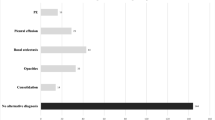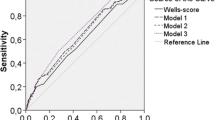Abstract
Objectives
We explored the variations in use of imaging modalities for confirming pulmonary embolism (PE) according to the trimester of pregnancy.
Methods
We included all pregnant patients with confirmed acute PE from RIETE, a prospective registry of patients with PE (03/2001–02/2020). Imaging modalities included computed tomography pulmonary angiography (CTPA), ventilation-perfusion (V/Q) scan, or presence of signs of acute PE along with imaging-confirmed proximal deep vein thrombosis (pDVT) without pulmonary vascular imaging. We compared the imaging modalities to postpartum patients with PE, and other non-pregnant women with PE.
Results
There were 157 pregnant patients (age: 32.7 ± 0.5), 228 postpartum patients (age: 33.9 ± 0.5), and 23,937 non-pregnant non-postpartum women (age: 69.5 ± 0.1). CTPA was the most common modality for confirming PE, from 55.7% in first trimester to 58.3% in second trimester, and 70.0% in third trimester. From first trimester to third trimester, V/Q scanning was used in 21.3%, 16.7%, and 18.3% of cases, respectively. Confirmed pDVT along with the presence of signs/symptoms of PE was the confirmatory modality for PE in 21.3% of patients in first trimester, 19.4% in second trimester, and 6.7% in third trimester. The proportion of postpartum patients confirmed with CTPA (85.5%) was comparable to that of non-pregnant non-postpartum women (83.2%). From the first trimester of pregnancy to postpartum period, there was a linear increase in the proportion of patients with PE diagnosed with CTPA (p = 0.039).
Conclusion
CTPA was the primary modality for confirming PE in all trimesters of pregnancy, although its proportional use was higher in later stages of pregnancy.
Key Points
• Computed tomography pulmonary angiography (CTPA) was the primary modality of diagnosis in all trimesters of pregnancy among patients with confirmed pulmonary embolism, even in the first trimester.
• From the first trimester of pregnancy to postpartum period, there was a linear increase in the proportion of patients with pulmonary embolism who were diagnosed based on CTPA.
• In the postpartum period, use of CTPA as the modality to confirm pulmonary embolism was comparable to non-pregnant patients.


Similar content being viewed by others
Abbreviations
- CTPA:
-
Computed tomography pulmonary angiography
- IQR:
-
Interquartile range
- pDVT:
-
Proximal deep vein thrombosis
- PE:
-
Pulmonary embolism
- RIETE:
-
Registro Informatizado Enfermedad TromboEmbolica
- SEM:
-
Standard error of mean
- V/Q scan:
-
Ventilation-perfusion scan
- VTE:
-
Venous thromboembolism
References
James AH, Jamison MG, Brancazio LR, Myers ER (2006) Venous thromboembolism during pregnancy and the postpartum period: incidence, risk factors, and mortality. Am J Obstet Gynecol 194:1311–1315
Elgendy IY, Fogerty A, Blanco-Molina Á et al (2020) Clinical characteristics and outcomes of women presenting with venous thromboembolism during pregnancy and postpartum period: findings from the RIETE Registry. Thromb Haemost 120:1454–1462
Mehdipoor G, Jimenez D, Bertoletti L et al (2020) Patient-level, institutional, and temporal variations in use of imaging modalities to confirm pulmonary embolism. Circ Cardiovasc Imaging 13:e010651
Kirsch J, Brown RKJ, Henry TS et al (2017) ACR Appropriateness Criteria(®) acute chest pain-suspected pulmonary embolism. Journal of the American College of Radiology : JACR 14:S2–s12
Cohen SL, Feizullayeva C, McCandlish JA et al (2020) Comparison of international societal guidelines for the diagnosis of suspected pulmonary embolism during pregnancy. Lancet Haematol 7:e247–e258
Wan T, Skeith L, Karovitch A, Rodger M, Le Gal G (2017) Guidance for the diagnosis of pulmonary embolism during pregnancy: consensus and controversies. Thromb Res 157:23–28
Tester J, Hammerschlag G, Irving L, Pascoe D, Rees M (2020) Investigation and diagnostic imaging of suspected pulmonary embolism during pregnancy and the puerperium: a review of the literature. J Med Imaging Radiat Oncol 64:505–515
Tomà P, Bartoloni A, Salerno S et al (2019) Protecting sensitive patient groups from imaging using ionizing radiation: effects during pregnancy, in fetal life and childhood. Radiol Med 124:736–744
Ridge CA, McDermott S, Freyne BJ, Brennan DJ, Collins CD, Skehan SJ (2009) Pulmonary embolism in pregnancy: comparison of pulmonary CT angiography and lung scintigraphy. AJR Am J Roentgenol 193:1223–1227
Ridge CA, Mhuircheartaigh JN, Dodd JD, Skehan SJ (2011) Pulmonary CT angiography protocol adapted to the hemodynamic effects of pregnancy. AJR Am J Roentgenol 197:1058–1063
Bikdeli B, Jimenez D, Hawkins M et al (2018) Rationale, design and methodology of the computerized registry of patients with venous thromboembolism (RIETE). Thromb Haemost 118:214–224
van Mens TE, Scheres LJ, de Jong PG, Leeflang MM, Nijkeuter M, Middeldorp S (2017) Imaging for the exclusion of pulmonary embolism in pregnancy. Cochrane Database Syst Rev 1:Cd011053
Rubin GD, Leipsic J, Joseph Schoepf U, Fleischmann D, Napel S (2014) CT angiography after 20 years: a transformation in cardiovascular disease characterization continues to advance. Radiology 271:633–652
Tromeur C, van der Pol LM, Le Roux PY et al (2019) Computed tomography pulmonary angiography versus ventilation-perfusion lung scanning for diagnosing pulmonary embolism during pregnancy: a systematic review and meta-analysis. Haematologica 104:176–188
Winer-Muram HT, Boone JM, Brown HL, Jennings SG, Mabie WC, Lombardo GT (2002) Pulmonary embolism in pregnant patients: fetal radiation dose with helical CT. Radiology 224:487–492
Astani SA, Davis LC, Harkness BA, Supanich MP, Dalal I (2014) Detection of pulmonary embolism during pregnancy: comparing radiation doses of CTPA and pulmonary scintigraphy. Nucl Med Commun 35:704–711
van der Pol LM, Tromeur C, Bistervels IM et al (2019) Pregnancy-adapted YEARS algorithm for diagnosis of suspected pulmonary embolism. N Engl J Med 380:1139–1149
Righini M, Robert-Ebadi H, Elias A et al (2018) Diagnosis of pulmonary embolism during pregnancy: a multicenter prospective management outcome study. Ann Intern Med 169:766–773
Zhang W, Shen J, Sun JL (2020) Risk scores, prevention, and treatment of maternal venous thromboembolism. World J Clin Cases 8:2210–2218
Haas S, Ageno W, Weitz JI et al (2019) Anticoagulation therapy patterns for acute treatment of venous thromboembolism in GARFIELD-VTE patients. J Thromb Haemost 17:1694–1706
Jerjes-Sánchez C, Rodriguez D, Farjat AE et al (2021) Pregnancy-associated venous thromboembolism: insights from GARFIELD-VTE. TH Open 5:e24–e34
Righini M, Robert-Ebadi H, Le Gal G (2017) Diagnosis of acute pulmonary embolism. J Thromb Haemost 15:1251–1261
Konstantinides SV, Meyer G, Becattini C , et al. (2019) 2019 ESC Guidelines for the diagnosis and management of acute pulmonary embolism developed in collaboration with the European Respiratory Society (ERS): the Task Force for the diagnosis and management of acute pulmonary embolism of the European Society of Cardiology (ESC). Eur Respir J 54
Leung AN, Bull TM, Jaeschke R et al (2012) American Thoracic Society documents: an official American Thoracic Society/Society of Thoracic Radiology Clinical Practice Guideline--evaluation of suspected pulmonary embolism in pregnancy. Radiology 262:635–646
McLintock C, Brighton T, Chunilal S et al (2012) Recommendations for the diagnosis and treatment of deep venous thrombosis and pulmonary embolism in pregnancy and the postpartum period. Aust N Z J Obstet Gynaecol 52:14–22
Linnemann B, Bauersachs R, Rott H et al (2016) Diagnosis of pregnancy-associated venous thromboembolism - position paper of the Working Group in Women's Health of the Society of Thrombosis and Haemostasis (GTH). Vasa 45:87–101
Chan WS, Rey E, Kent NE et al (2014) Venous thromboembolism and antithrombotic therapy in pregnancy. J Obstet Gynaecol Can 36:527–553
Bajc M, Neilly JB, Miniati M, Schuemichen C, Meignan M, Jonson B (2009) EANM guidelines for ventilation/perfusion scintigraphy : part 2. Algorithms and clinical considerations for diagnosis of pulmonary emboli with V/P(SPECT) and MDCT. Eur J Nucl Med Mol Imaging 36:1528–1538
Mehdipoor G, Bikdeli B, Prince MR (2019) Diagnosis of suspected pulmonary embolism in pregnancy. N Engl J Med 380:e49
Acknowledgements
We express our gratitude to Sanofi Spain and LEO PHARMA for supporting this Registry with an unrestricted educational grant. We also thank the RIETE Registry Coordinating Center, S&H Medical Science Service, for their quality control data, and logistic and administrative support, and Prof. Salvador Ortiz, Universidad Autónoma Madrid and Silvia Galindo, both Statistical Advisors in S&H Medical Science Service, for the statistical analysis of the data presented in this paper.
Funding
We express our gratitude to Sanofi Spain for supporting this Registry with an unrestricted educational grant. No additional specific funding support was sought or provided for the current investigation.
Author information
Authors and Affiliations
Consortia
Corresponding author
Ethics declarations
The ethics committees at all participating sites approved the protocol for enrolling patients in RIETE registry for research purposes, and all participating patients or their healthcare proxies provided written informed consent (https://clinicaltrials.gov/ct2/show/NCT02832245).
Guarantor
The scientific guarantor of this publication is Dr. Manuel Monreal.
Conflict of interest
Dr. Bikdeli reports that he is a consulting expert, on behalf of the plaintiff, for litigation related to two specific brand models of IVC filters. The authors of this manuscript declare no relationships with any companies whose products or services may be related to the subject matter of the article.
Statistics and biometry
No complex statistical methods were necessary for this paper.
Informed consent
Written informed consent was waived by the Institutional Review Board.
Ethical approval
Institutional Review Board approval was obtained.
Additional information
Publisher’s note
Springer Nature remains neutral with regard to jurisdictional claims in published maps and institutional affiliations.
A full list of the RIETE investigators is given in the appendix
Supporting Information
ESM 1
(DOC 414 kb)
Rights and permissions
About this article
Cite this article
Mehdipoor, G., Jimenez, D., Bertoletti, L. et al. Imaging modalities for confirming pulmonary embolism during pregnancy: results from a multicenter international study. Eur Radiol 32, 1238–1246 (2022). https://doi.org/10.1007/s00330-021-08161-9
Received:
Revised:
Accepted:
Published:
Issue Date:
DOI: https://doi.org/10.1007/s00330-021-08161-9




